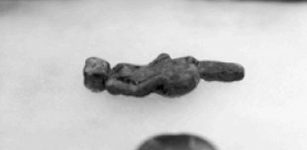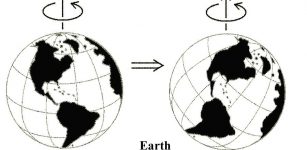Our Ancestors Had A Tail And Lost It Twice
Eddie Gonzales Jr. – MessageToEagle.com – Our ancestors had a tail, and they lost it twice. We modern humans have only a “vestigial” tail, an evolutionary leftover. It is visible in embryos, but by birth, we only have a few small bones that cannot be seen from the outside.
The tailbone is vestigial, an organ or human trait that has lost its original function through evolution. The tailbone is part of a larger group of features that have gone out of use.
Why we lost our tail has been a scientific mystery, but new research conducted by paleontologists from the University of Pennsylvania sheds some light on this evolution enigma.
The origins of this mysterious vestigial tail can be traced back to fish. To learn more about how ancestors lost their tail, researchers studied a 350-million-year-old hatchlings of the fossil fish Aetheretmon that possessed an asymmetrical tail, longer on the top than the bottom, containing vertebrae.
When Lauren Sallan, an assistant professor in the School of Arts & Science’s Department of Earth and Environmental Science, compared the Aetheretmon hatchlings with those of living fish, she discovered something surprising. The two “tails” started out one atop the other and then grew on their own. This discovery is highly significant because, for nearly 200 years, scientists assumed that the modern adult fish tail fin was added to the end of an ancestral tail shared with land animals.
 Image credit: UCSB Science Line
Image credit: UCSB Science Line
“The tetrapod tail likely started as a limb-like outgrowth in the first vertebrates, while the fish caudal fin started as a co-opted median fin, like the dorsal fin. All vertebrate tail diversity might be explained by the relative growth and loss of these two tails, with the remaining fleshy tail stunted in humans as in fishes,” Sallan said.
The disconnect means that the two tails went on their evolutionary paths. Fish lost the fleshy tail and kept the flexible ones to improve their swimming. She explained that just the back fin “allows for more refined movements, which a muscular tail (originally present for power swimming) would disrupt.”
 Aetheretmon (facing right) display the ancestral state of two tails, a fleshy one on top of a fin. Teleosts (middle) and tetrapods have each lost one. Credit: John Megahan
Aetheretmon (facing right) display the ancestral state of two tails, a fleshy one on top of a fin. Teleosts (middle) and tetrapods have each lost one. Credit: John Megahan
Adult apes, including human ancestors, took the tail loss process further. Sallan said, “losing the remaining bony tail for better upright movement. Like fish, the remnants of an embryonic bony tail are buried in our lower backs—the coccyx or tailbone—stunted by a loss of molecular signals that would otherwise cause it to grow out like an arm or leg. Thus, humans and fish embryos share mechanisms for controlling tail form.”
Today, most people don’t even know they have tailbones unless they break one. In rare cases, some people are born with a fully functioning tail. It has happened over 20 times in the past 100 years. When it happens, the tail is usually removed surgically.
Written by Eddie Gonzales Jr. – MessageToEagle.com Staff
Expand for referencesRelated Posts
-
 Illapa: Powerfull Master Of Clouds, Rain And Hail – Worshipped By Inca People
No Comments | Jul 7, 2016
Illapa: Powerfull Master Of Clouds, Rain And Hail – Worshipped By Inca People
No Comments | Jul 7, 2016 -
 A Teaspoon Of Soil Contains More Living Organisms Than There Are People On Earth
No Comments | Jan 11, 2016
A Teaspoon Of Soil Contains More Living Organisms Than There Are People On Earth
No Comments | Jan 11, 2016 -
 Himiko Cloud: Most Massive Object In The Early Universe
No Comments | Feb 4, 2016
Himiko Cloud: Most Massive Object In The Early Universe
No Comments | Feb 4, 2016 -
 Barbarians Were People Who Didn’t Speak Greek
No Comments | Jan 18, 2016
Barbarians Were People Who Didn’t Speak Greek
No Comments | Jan 18, 2016 -
 Nampa Figurine That Strongly Challenges The Evolutionary Scenario: Controversial Case Of Extreme Human Antiquity
No Comments | May 11, 2014
Nampa Figurine That Strongly Challenges The Evolutionary Scenario: Controversial Case Of Extreme Human Antiquity
No Comments | May 11, 2014 -
 Sleep Paralysis: Being Awake And Unable To Move
No Comments | Feb 17, 2016
Sleep Paralysis: Being Awake And Unable To Move
No Comments | Feb 17, 2016 -
 10 Great Ancient Life Lessons From Buddha How To Change Your Life Rapidly
No Comments | Jul 16, 2015
10 Great Ancient Life Lessons From Buddha How To Change Your Life Rapidly
No Comments | Jul 16, 2015 -
 Lachit Bhorphukan: Hero From Assam Among Famous Warriors Who Stopped Mughals From Conquering Northeast India
No Comments | Dec 28, 2016
Lachit Bhorphukan: Hero From Assam Among Famous Warriors Who Stopped Mughals From Conquering Northeast India
No Comments | Dec 28, 2016 -
 Gluskap: Mythical Hero Who Defeated Evil Sorcerers And Demon Followers
No Comments | Jan 25, 2016
Gluskap: Mythical Hero Who Defeated Evil Sorcerers And Demon Followers
No Comments | Jan 25, 2016 -
 Phenomenon Of True Polar Wander: What Is It?
No Comments | Jun 14, 2017
Phenomenon Of True Polar Wander: What Is It?
No Comments | Jun 14, 2017

